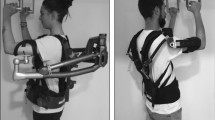Abstract
Work-related musculoskeletal disorders have a high prevalence across industries and are a leading cause for days away from work. Exoskeletons can assist their users during physically demanding tasks to reduce the workload and the prevalence of work-related musculoskeletal disorders. This paper explores the physiological effect of a novel passive shoulder exoskeleton on the development of fatigue during overhead work.
A sample of 32 healthy participants performed a two-minute isometric task simulating tool handling above shoulder level with and without the exoskeleton. Muscular activation and fatigue in the arm, shoulder, neck and back muscles were recorded using surface electromyography. Cardiac cost was measured using optical heart rate tracking at the wrist.
The exoskeleton significantly reduced muscle activity in shoulder, neck and back muscles up to 32% (p<0.01) and reduced the rate of fatiguing up to 45% (p<0.01) in the Deltoidanterior. The cardiac cost while performing the task with the exoskeleton was 16% (p<0.05) less than without the exoskeleton.
Using the proposed passive shoulder support exoskeleton substantially reduced the muscular load and perceived effort as well as the cardiovascular load. This suggests users can perform overhead tool-handling tasks for longer periods of time while feeling less tired. It also might positively influence the development of injuries.
Access this chapter
Tax calculation will be finalised at checkout
Purchases are for personal use only
Similar content being viewed by others
References
Barthelme, J., Sauter, M., Mueller, C., Liebers, F.: Association between working in awkward postures, in particular overhead work, and pain in the shoulder region in the context of the 2018 BIBB/BAuA Employment Survey. BMC Musculoskelet. Disord. 22, 1–12 (2021). https://doi.org/10.1186/s12891-021-04482-4
Bureau of Labor Statistics, U.S.: Nonfatal occupational injuries and illnesses requiring days away from work. Press Office Bureau of Labor Statistics (2016). https://www.bls.gov/news.release/archives/osh2_11102016.pdf
Coorevits, P., Danneels, L., Cambier, D., Ramon, H., Vanderstraeten, G.: Assessment of the validity of the Biering-Sørensen test for measuring back muscle fatigue based on EMG median frequency characteristics of back and hip muscles. J. Electromyogr. Kinesiol. 18(6), 997–1005 (2008). https://doi.org/10.1016/j.jelekin.2007.10.012
De Bock, S., et al.: Benchmarking occupational exoskeletons: an evidence mapping systematic review. Appl. Ergon. 98, 103582 (2022). https://doi.org/10.1016/j.apergo.2021.103582
Dedering, Å., Németh, G., Harms-Ringdahl, K.: Correlation between electromyographic spectral changes and subjective assessment of lumbar muscle fatigue in subjects without pain from the lower back. Clin. Biomech. 14(2), 103–111 (1999). https://doi.org/10.1016/s0268-0033(98)00053-9
Demers, L., Weiss-Lambrou, R., Ska, B.: Quebec user evaluation of satisfaction with assistive technology (QUEST). Assist. Technol. 12(2), 96–105 (2000). https://doi.org/10.1080/10400435.2000.10132015
Desbrosses, K., Schwartz, M., Theurel, J.: Evaluation of two upper-limb exoskeletons during overhead work: influence of exoskeleton design and load on muscular adaptations and balance regulation. Eur. J. Appl. Physiol. 121(10), 2811–2823 (2021). https://doi.org/10.1007/s00421-021-04747-9
Gilotta, S., Spada, S., Ghibaudo, L., Isoardi, M., Mosso, C.O.: Acceptability beyond usability: a manufacturing case study. In: Bagnara, S., Tartaglia, R., Albolino, S., Alexander, T., Fujita, Y. (eds.) IEA 2018. AISC, vol. 824, pp. 922–934. Springer, Cham (2019). https://doi.org/10.1007/978-3-319-96071-5_95
Grazi, L., Trigili, E., Proface, G., Giovacchini, F., Crea, S., Vitiello, N.: Design and experimental evaluation of a semi-passive upper-limb exoskeleton for workers with motorized tuning of assistance. IEEE Trans. Neural Syst. Rehabil. Eng. 28(10), 2276–2285 (2020). https://doi.org/10.1109/TNSRE.2020.3014408
Hyun, D.J., Bae, K.H., Kim, K.J., Nam, S., Lee, D.H.: A light-weight passive upper arm assistive exoskeleton based on multi-linkage spring-energy dissipation mechanism for overhead tasks. Rob. Auton. Syst. 122, 103309 (2019). https://doi.org/10.1016/j.robot.2019.103309
Kok, J., et al.: Work-related MSDs: prevalence, costs and demographics in the EU. Publ. Off. Eur. Union (2019). https://doi.org/10.2802/66947
Lamers, E.P., Soltys, J.C., Scherpereel, K.L., Yang, A.J., Zelik, K.E.: Low-profile elastic exosuit reduces back muscle fatigue. Sci. Rep. 10(1), 1–16 (2020). https://doi.org/10.1038/s41598-020-72531-4
Lee, Y., Chee, Y.: Evaluation of the effectiveness of muscle assistive device using muscle fatigue analysis. In: Annual International Conference of the IEEE Engineering in Medicine and Biology Society, pp. 2112–2115. IEEE Press, New York (2013). https://doi.org/10.1109/EMBC.2013.6609950
Pacifico, I., et al.: An Experimental evaluation of the proto-MATE: a novel ergonomic upper-limb exoskeleton for reducing the worker’s physical strain. IEEE Robot. Autom. Mag. 16(23), 54–65 (2020). https://doi.org/10.1109/MRA.2019.2954105
Schmalz, T., et al.: Biomechanical and metabolic effectiveness of an industrial exoskeleton for overhead work. Int. J. Environ. Res. Public Health 16(23), 4792 (2019). https://doi.org/10.3390/ijerph16234792
Sood, D., Nussbaum, M.A., Hager, K.: Fatigue during prolonged intermittent overhead work: reliability of measures and effects of working height. Ergonomics 50(4), 497–513 (2007). https://doi.org/10.1080/00140130601133800
Spada, S., Ghibaudo, L., Carnazzo, C., Gastaldi, L., Cavatorta, M.P.: Passive upper limb exoskeletons: an experimental campaign with workers. In: Bagnara, S., Tartaglia, R., Albolino, S., Alexander, T., Fujita, Y. (eds.) IEA 2018. AISC, vol. 825, pp. 230–239. Springer, Cham (2019). https://doi.org/10.1007/978-3-319-96068-5_26
Spada, S., Ghibaudo, L., Gilotta, S., Gastaldi, L., Cavatorta, M.P.: Investigation into the applicability of a passive upper-limb exoskeleton in automotive industry. Procedia Manuf. 11, 1255–1262 (2017). https://doi.org/10.1016/j.promfg.2017.07.252
Acknowledgment
We thank Flavio Müller for his contribution to the exoskeleton development, Julia van Sluijs for the anatomical drawing and Tobias Luder and Cherilyn Camichel for their contribution to recruitment and data collection.
Author information
Authors and Affiliations
Corresponding author
Editor information
Editors and Affiliations
Rights and permissions
Copyright information
© 2023 The Author(s), under exclusive license to Springer Nature Switzerland AG
About this paper
Cite this paper
Brunner, A. et al. (2023). Effect of a Passive Shoulder Support Exoskeleton on Fatigue During Working with Arms over Shoulder Level. In: Tarnita, D., Dumitru, N., Pisla, D., Carbone, G., Geonea, I. (eds) New Trends in Medical and Service Robotics. MESROB 2023. Mechanisms and Machine Science, vol 133. Springer, Cham. https://doi.org/10.1007/978-3-031-32446-8_21
Download citation
DOI: https://doi.org/10.1007/978-3-031-32446-8_21
Published:
Publisher Name: Springer, Cham
Print ISBN: 978-3-031-32445-1
Online ISBN: 978-3-031-32446-8
eBook Packages: EngineeringEngineering (R0)




